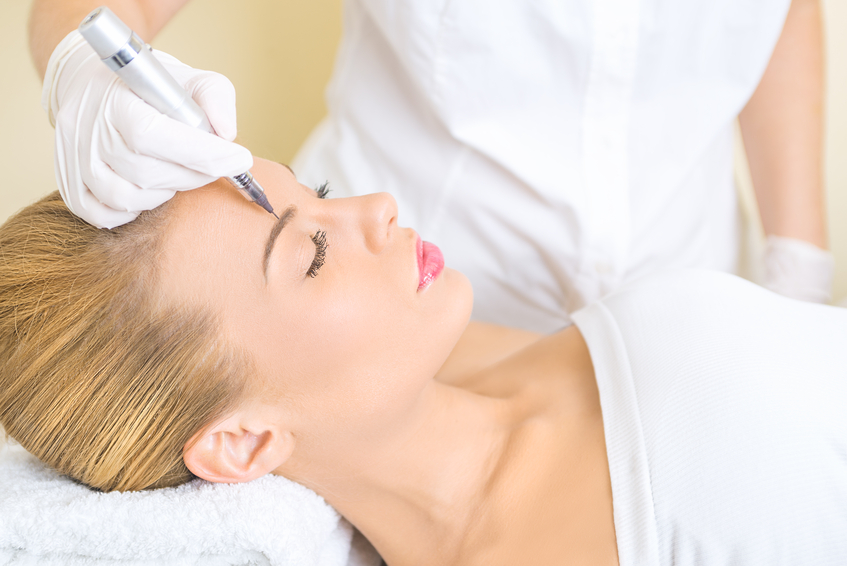
It’s a well-known fact in the beauty industry that eyebrows set the stage. They frame bone structure, make eyes pop, and can add personality to a face. To help get the perfect set of brows, many women have turned to make-up and even permanent make-up for a solution. However, there’s a new procedure that holds a lot of promise.In many ways, microblading professionals can consider themselves eyebrow miracle workers. Microblading has been increasing in popularity over the past several years, with people everywhere jumping on the trend.Microblading is a welcomed step forward from traditional permanent eyebrow make-up. Curious to learn the difference between the two? Keep reading to find out!
1. Students in Microblading Training Know Microblading Offers a More Natural Look
One of the most obvious differences between microblading and permanent make-up is how it looks. Permanent make-up is an older technique that creates a thick solid line. It is designed to resemble make-up, but can often look very unnatural, with some even saying it makes eyebrows appear drawn on with a Sharpie.Microblading is not designed to look like make-up. Instead, it’s meant to look like actual hair strokes. As you will learn through hands-on practice during your
microblading training, the strokes are individual and thin, giving the illusion of real hair. That realistic look even helped earn microblading the nickname “3D brows.”

Microbladed eyebrows looks so realistic they are called 3D brows
2. Students in Microblading Training May Know the Difference Between the Tools Used
So, what are the differences in the way each look is created? The answer mostly lies within the tools professionals use. Permanent make-up uses a traditional tattoo gun with a rotary and coil to draw on eyebrows. Because of this approach, it’s hard to get precise and small lines, which causes eyebrows to look thicker and less natural.Microblading, on the other hand, uses a small blade with many micro needles to create fine hair strokes. It is a manual tool and each stroke is individually pressed in by a professional. The blade is dipped into ink and then carefully pressed into the first two layers of a client’s skin. Because of the precision involved in this procedure, the lines stay sharp and the ink does not bleed—unlike traditional permanent make-up.
3. Students in Microblading Courses May Know that Permanent Make-up Lasts Longer
One of the most significant differences between these two methods is how long they last. As you’ll soon learn during your
microblading course, microblading is a semi-permanent procedure. This is due to a combination of factors, such as the ink used. With microblading, semi-permanent ink is used so that over time the ink naturally dissipates and disappears. In addition, microblading deposits the ink much more shallowly into a client’s skin. By comparison, permanent make-up is as permanent as any other tattoo. The ink is deposited much deeper into the skin, and is designed to stay throughout the course of a client’s life.Which one is better? While it may be disappointing to some that microblading only lasts for one to three years, this is actually a benefit. Over time, the pigment in permanent make-up may turn blue or brown, whereas the ink used in microblading procedures will not. Also, if styles change—which they likely will if history repeats itself (remember the early 2000s, when tweezers were everyone’s best friend?)—your clients have the freedom to change up their eyebrows’ shape and colour.
Are you interested in obtaining your microblading certificate?Contact International Beauty Institute today so you can start transforming eyebrows!  It’s a well-known fact in the beauty industry that eyebrows set the stage. They frame bone structure, make eyes pop, and can add personality to a face. To help get the perfect set of brows, many women have turned to make-up and even permanent make-up for a solution. However, there’s a new procedure that holds a lot of promise.In many ways, microblading professionals can consider themselves eyebrow miracle workers. Microblading has been increasing in popularity over the past several years, with people everywhere jumping on the trend.Microblading is a welcomed step forward from traditional permanent eyebrow make-up. Curious to learn the difference between the two? Keep reading to find out!
It’s a well-known fact in the beauty industry that eyebrows set the stage. They frame bone structure, make eyes pop, and can add personality to a face. To help get the perfect set of brows, many women have turned to make-up and even permanent make-up for a solution. However, there’s a new procedure that holds a lot of promise.In many ways, microblading professionals can consider themselves eyebrow miracle workers. Microblading has been increasing in popularity over the past several years, with people everywhere jumping on the trend.Microblading is a welcomed step forward from traditional permanent eyebrow make-up. Curious to learn the difference between the two? Keep reading to find out!

